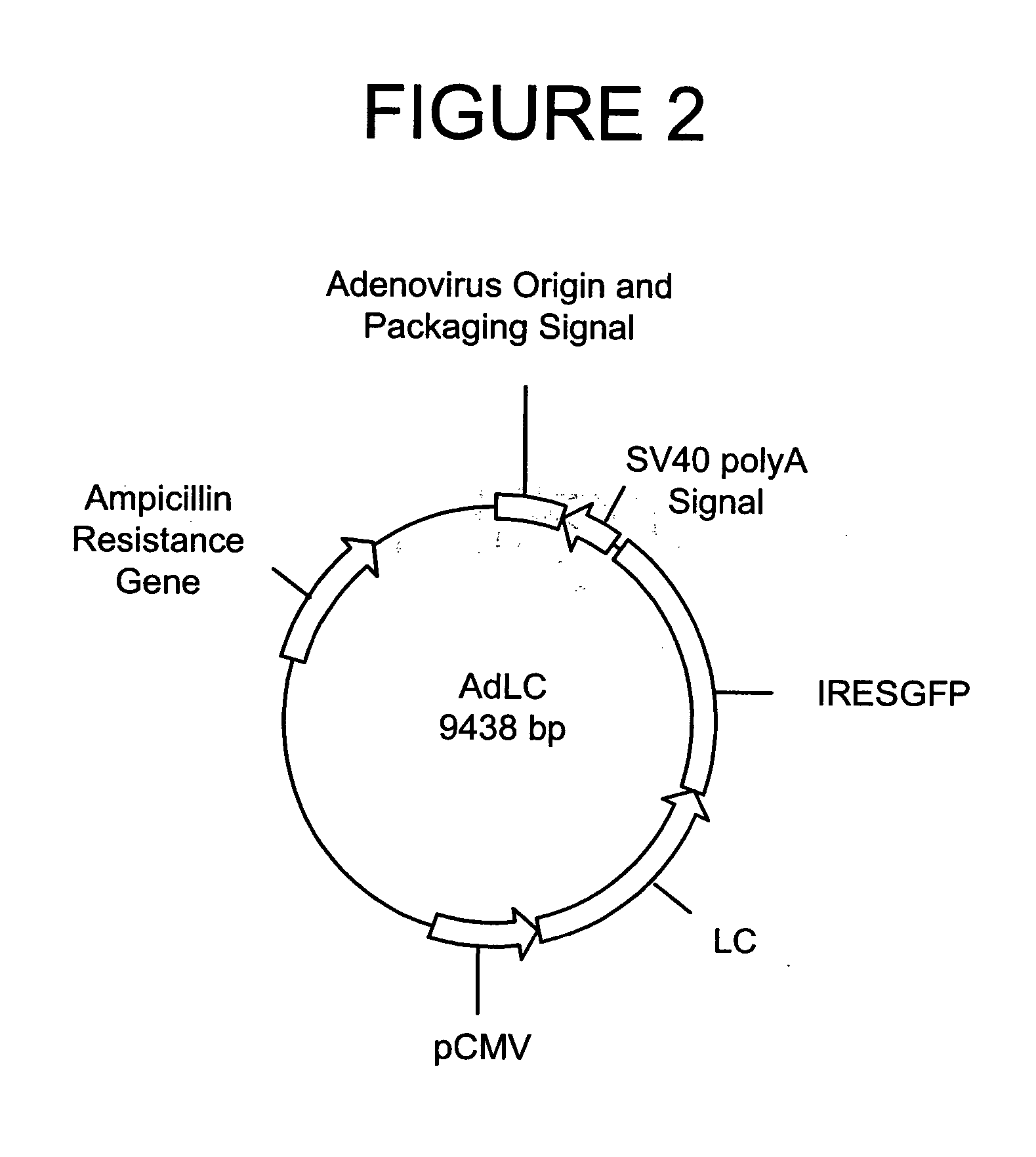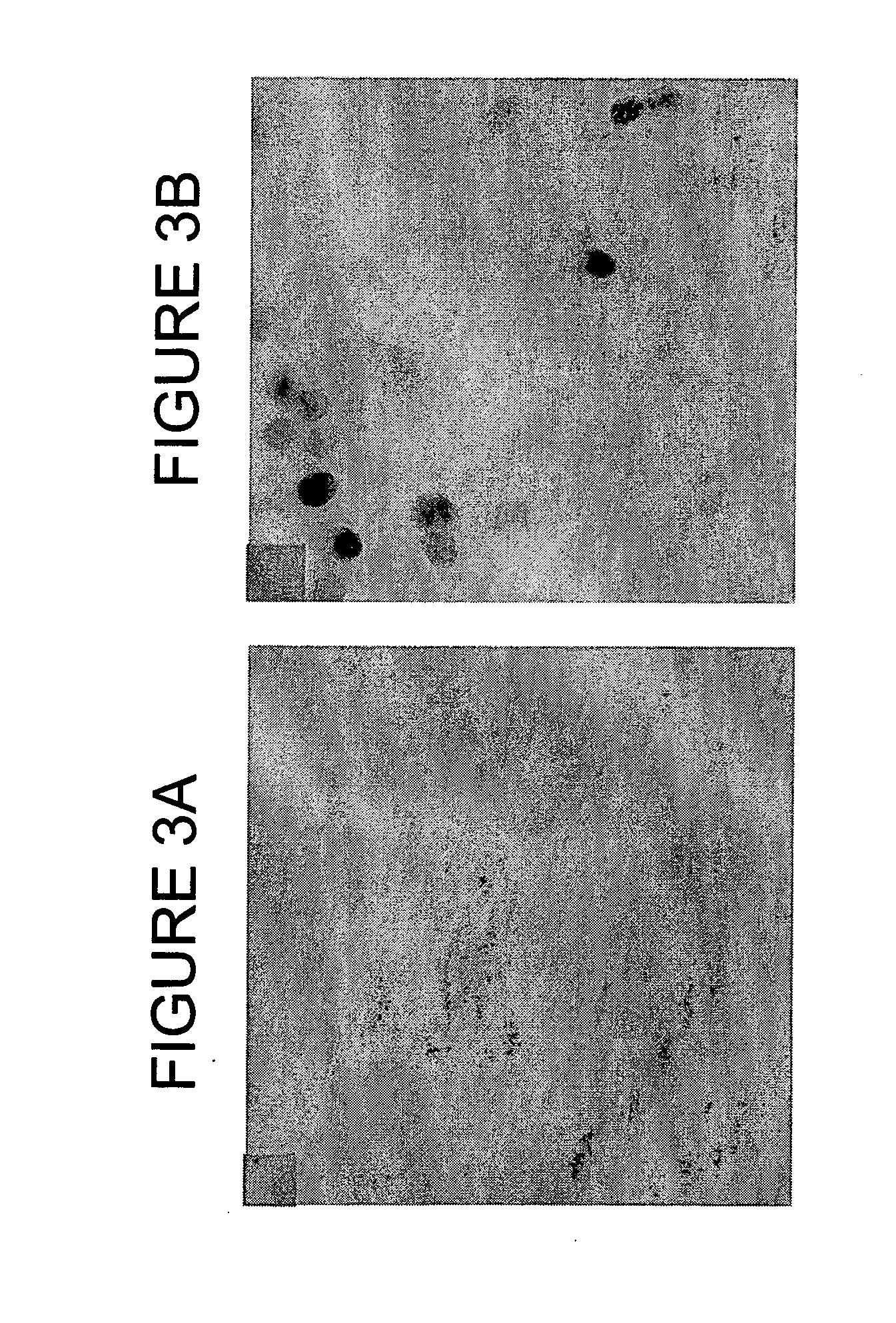In vivo production of a clostridial neurotoxin light chain peptide
a neurotoxin and light chain technology, applied in the field of cell in vivo production of clostridial neurotoxin light chain peptides, can solve problems such as muscle paralysis
- Summary
- Abstract
- Description
- Claims
- Application Information
AI Technical Summary
Benefits of technology
Problems solved by technology
Method used
Image
Examples
example 1
Construction of a Vector (AdLC) Containing a Gene Encoding the Light Chain of Tetanus Toxin (LC) and Expression of the LC Gene from the AdLC
A 1496 base pair synthetic gene having a nucleic acid sequence of GenBank Accession No. L19522 (LC gene) encoding the light chain of a tetanus toxin peptide (LC peptide) is cloned into an adenovirus vector pACCMVpLpA(−)loxP.SSP under the control of a cytomegalovirus (CMV) promoter. For easier identification of gene expression in vitro and in vivo, an internal ribosome entry site (IRES)-driven green fluorescent protein (GFP) sequence is cloned downstream of the LC gene into the pACCMVpLpA(−)loxP.SSP vector. An attenuated adenovirus vectors (the E1A, E1B, and E3 regions of the adenovirus (wildtype Ad5) genome are deleted) is produced through in vitro recombination with the sub360loxp cosmid as described below. The resulting vector is named pAdLC and is schematically illustrated in FIG. 2. Two more vectors are produced and purified following the ...
example 2
Construction of AAV Vectors (AAVCMVLC and AAVTet-onLC) Containing a Gene Encoding the Light Chain of Tetanus Toxin (LC) and Expression of the LC Gene from these Vectors
A pTRUF-5 plasmid (Nicholas Muzyczka, University of Florida, Gainsville) is used for the creation of a recombinant adeno-associated virus (AAV-GFP). pTRUF-5 contains gene for GFP under control of CMV promoter. In order to make adequate room in the pTRUF-5 plasmid, the neo resistance sequence is removed by restriction digest. A separate restriction digestion is performed with Not I to remove the GFP sequence. The sequence of the LC-IRES-GFP is cloned into pTRUF-5 between the Not I sites (such resulting vector being named pTRUF-5LC). Restriction mapping is conducted to ensure the proper orientation of the LC gene. This strategy resulted in the creation of an AAV vector containing the LC gene and IRES-GFP sequences under the control of the CMV promoter with an associated 3′ polyA sequence.
For harvesting viruses, trip...
example 3
LC Gene Expression Results in Cleavage of the VAMP-1 SNARE Protein
Differentiated pheochromocytoma-12 (PC12) cells induced with nerve growth factor (NGF) (Sigma Aldrich. St. Louis, Mo.) at a concentration of 50 ng / ml are infected with AdLC, AdLacZ or AdGFP vectors (see Example 1) at a m.o.i. of 5 for 48 hours. The PC12 cells are lysed and the resulting cell lysate is used as a source of LC peptide and control peptide for the subsequent enzymatic digestion of mice cortex tissue containing VAMP-1.
Five μg of protein extracted from mouse cortex protein containing VAMP-1 is incubated with peptides obtained from PC12 cells infected with AdLC, AdLacZ or AdGFP in a light chain reaction buffer (5 mM HEPES, 0.3 M Glycine, 0.3 M NaCl, 0.02% NaN3, pH 7.4) at 37° C. A concentration-response curve of cortical VAMP-1 digestion is carried out with 1, 5, 10, 15, and 20 microliters (μl) of cell lysate containing AdLC. To test time-dependence of VAMP-1 digestion, incubation is also performed for 6,...
PUM
| Property | Measurement | Unit |
|---|---|---|
| temperature | aaaaa | aaaaa |
| pH | aaaaa | aaaaa |
| pH | aaaaa | aaaaa |
Abstract
Description
Claims
Application Information
 Login to View More
Login to View More - R&D
- Intellectual Property
- Life Sciences
- Materials
- Tech Scout
- Unparalleled Data Quality
- Higher Quality Content
- 60% Fewer Hallucinations
Browse by: Latest US Patents, China's latest patents, Technical Efficacy Thesaurus, Application Domain, Technology Topic, Popular Technical Reports.
© 2025 PatSnap. All rights reserved.Legal|Privacy policy|Modern Slavery Act Transparency Statement|Sitemap|About US| Contact US: help@patsnap.com



